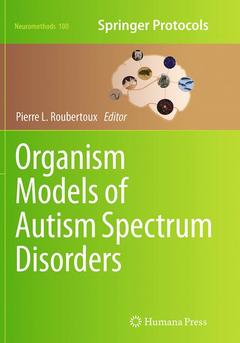Description
Organism Models of Autism Spectrum Disorders, Softcover reprint of the original 1st ed. 2015
Neuromethods Series, Vol. 100
Coordinator: Roubertoux Pierre L.
Language: English
Subjects for Organism Models of Autism Spectrum Disorders:
Support: Print on demand
487 p. · 17.8x25.4 cm · Hardback
Description
/li>Contents
/li>Comment
/li>
As autism is associated with many rare diseases, this extensive bench book examines how no one single model can be used; multiple organism models are needed, each one corresponding to one of the diseases or to one aspect of a disease. Split into five sections, Organism Models of Autism Spectrum Disorders explores selecting the good species for the specific disease, modeling autism spectrum disorders (ASD) at the brain level, studying communication and social interactions, using vertebrates or invertebrate models of ASD as defined by DSM-5R, as well as pursuing models of diseases associated with an increased incidence of ASDs. Written for the respected Neuromethods series, this detailed volume contains the kind of insight and useful, practical advice that ensures more successful results in the lab.
Comprehensive and handy, Organism Models of Autism Spectrum Disorders will benefit psychiatrists and geneticists, as well as behavioral researchers who, realizing how important it is to improve their knowledge through more molecular approaches, are looking for the most suitable organisms.
Part I: Organism Models of Autism Spectrum Disorders: Selecting the Good Species
1. Organism Models: Choosing the Right Model
Nicolas Lévy and Pierre L. Roubertoux
2. The Autistic Spectrum Disorders (ASD) : From the Clinics to the Molecular Analysis
Pierre L. Roubertoux and Sylvie Tordjman
3. Selecting the Right Species: Practical Information on Organism Models
Catherine Bartoli, Arnaud Blanchard, Christine Buske, Gwenaelle Collod-Béroud, Laurent Fasano, Christophe Scajola, and Pierre L. Roubertoux
4. Viewing Animal Models for Tuberous Sclerosis Complex in the Light of Evolution
Christopher J. Howe, Jaco Serfontein, R. Ellen R. Nisbet, and Petrus J. de Vries
Part II: Modeling Autism Spectrum Disorder at the Brain Level
5. In Vivo Imaging in Mice
Nathalie Baril, Muriel Roth, and Rym Djouri
6. Invertebrate Models of Synaptic Transmission in Autism Spectrum Disorders
Manuel Ruiz-Rubio, Fernando Calahorro, and M. Mar Gámez-del-Estal
7. Epigenetic Factors in Normal and Pathological Neuronal Development
Natacha Broucqsault, Cherif Badja, Marie-Cécile Gaillard, and Frédérique Magdinier
8. Finding Endophenotypes for Autism Spectrum Disorders (ASD): cDNA Microarrays and Brain Transcripts
Patrice Bourgeois and Pierre Roubertoux
9. Serotonin Disturbance in Mouse Models of Autism Spectrum Disorders
Kota Tamada and Toru Takumi
Part III: Communication and Social Interactions
10. Communication and Language in Animals
Gene S. Fisch
11. Social Relationships in Nonhuman Primates: Potential Models of Pervasive Disorders
Vanessa A.D. Wilson and Alexander Weiss
12. Zebrafish Social Behaviour Testing in Developmental Brain Disorders
Christine Buske
Part IV: Mouse Models of Autism Spectrum Disorders as Defined by DSM-5R
13. Maintaining Mice for Neurobehavioral Examination
Pierre L. Roubertoux
14. Deficit in Social Relationships and Reduced Field of Interest in Mice
Pierre L. Roubertoux , Michèle Carlier, and Sylvie Tordjman
15. Modeling Autism Spectrum Disorders Motor Deficits in Mice
Pierre L. Roubertoux and Catherine Bartoli
Part V: Modeling Diseases with a High Prevalence of Autism Spectrum Disorders
16. Neuro-Behavioral Testing of Mouse Models of Rett Syndrome
Jean-Christophe Roux and Laurent Villard
17. Mouse Models of Tuberous Sclerosis
Dan Ehninger
18. Use of the Zebrafish Model to Understand Behavioral Disorders Associated with Altered Oxytocin System Development: Implications for Autism and Prader-Willi Syndrome
Nicole Johnston and Eric Glasgow
19. Epilogue: Perspectives and Caveats
Pierre L. Roubertoux
Includes cutting-edge methods and protocols for the use of a variety of organism models to explore ASD
Provides both the technical theory and practical aspects needed to achieve successful results in the lab
Contains key notes and implementation advice from the experts
These books may interest you

Handbook of Autism and Anxiety 158.24 €



